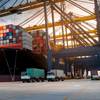LA, Long Beach Ports Focus on Updating Clean Air Action Plan
The governing boards of the Port of Los Angeles and the Port of Long Beach will hold a joint public meeting Nov. 17 to discuss proposals for updating the San Pedro Bay Ports Clean Air Action Plan (CAAP). Developed over the past year, the CAAP Discussion Document outlines the ports’ plans for expanding the aggressive strategies that have succeeded in dramatically reducing air pollution from port-related sources over the last decade.
The meeting will be held at 6 p.m., Thursday, Nov. 17, at the Port of Long Beach Maintenance Facility, 725 Harbor Plaza, Long Beach, 90802. The meeting will also be broadcast live online at www.portoflosangeles.org and www.polb.com. During the proceedings, port officials will recognize the 10th anniversary of the pioneering clean air plan, adopted in November 2006.
Highlights of the Discussion Document include the implementation of a path toward zero emissions, the next iteration of the Clean Truck Program, and innovative strategies to encourage the deployment of cleaner ships. The ports developed the proposals with input from industry, regulatory, community and environmental stakeholders. The Discussion Document will be available by Friday, Nov. 11, at www.polb.com, www.portoflosangeles.org and www.cleanairactionplan.org.
“The CAAP represents our commitment to reducing air quality impacts from port operations,” said Port of Long Beach Interim Chief Executive Duane Kenagy. “With this update, we are identifying the path forward to meet our clean air goals and curtail impacts on local communities.”
“CAAP has always been a living document,” said Port of Los Angeles Executive Director Gene Seroka. “We look forward to briefing our communities and getting their feedback on our proposals for taking our clean air strategies to the next level as we move toward our goal of zero emissions.”
Building on the success of the original plan and a 2010 update, the new iteration of the CAAP will contain a comprehensive set of near-term and long-term strategies to help the region achieve its clean air goals, support the statewide vision for more sustainable freight, and set a new goal to reduce greenhouse gas (GHG) emissions through 2050.
According to the latest annual inventories released earlier this year, the two ports’ comprehensive clean air programs have reduced diesel particulate matter (DPM) up to 85 percent, cut nitrogen oxides (NOx) in half, eliminated 97 percent of sulfur oxides (SOx), and shrunk GHG an average of 12 percent. The results reflect the ports’ combined clean air progress in collaboration with industry, regulatory, community and environmental partners since 2005, according to the latest annual inventories released earlier this year.
The results also show the ports continue to exceed their 2023 targets for reducing DPM and SOx (77 percent and 93 percent respectively) and are closing in on their 2023 target of reducing NOx emissions 59 percent.
The public review and comment process extends through Feb. 17, 2017. During this period, written comments can be submitted to [email protected]. The ports plan to release a draft of the 2017 CAAP Update for final review and consideration by their governing boards early next year.
The Port of Los Angeles and Port of Long Beach are the two largest ports in the nation, first and second respectively, and combined are the ninth-largest port complex in the world. The two ports handle approximately 40 percent of the nation’s total containerized import traffic and 25 percent of its total exports. Trade that flows through the San Pedro Bay ports complex generates more than 3 million jobs nationwide.














